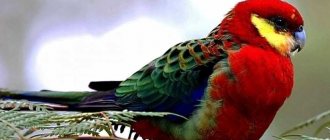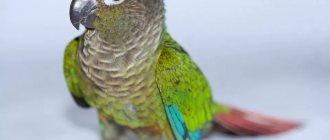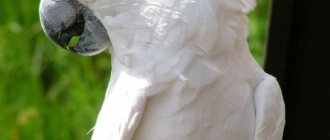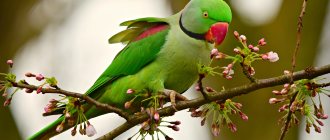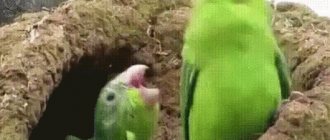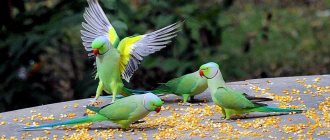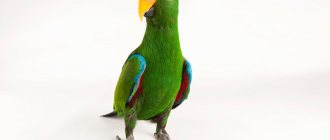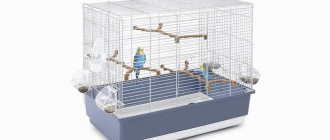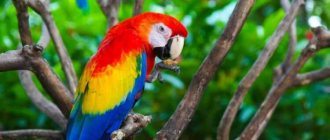There are a huge number of different animals and beasts on the globe. A number of them exist only in the wild; a number are started by people. Among the latter, parrots occupy far from the last place.
These feathered pets come in a variety of colors (from bright green to deep black), have different mental abilities (some easily learn human speech and even tricks, others can only chirp happily), behave differently (actively moving around the cage and quickly flying around the room or striding importantly across the floor.There is also a great variety in size - from small wavy ones to real giants, which will be discussed in this article.
Hyacinth macaw
A fairly well-known breed of parrots, which is distinguished by its blue plumage, and also has yellow feathers around the eyes and under the beak.
A fairly common second name for hyacinth macaws is “gentle giants.” The length of the body together with the tail can reach a meter (the second can be equal to half this value, and the weight reaches up to two kilograms. At the same time, their character is very soft - they are affectionate birds, they trust people and treat them with tenderness. Hyacinth macaws are often used in circus performances because of their ability to train and carry out various commands. But they rarely manage to repeat human speech. There are very few birds left in this nature, which is why it is extremely difficult to find them in the wild, and to acquire them as a pet almost impossible. If you manage to find a nursery or professional breeder, you will have to pay at least $30,000. In many countries, every effort is being made to restore the population, but this is not a quick process, it is quite possible that hyacinth macaws will soon reappear in the wild .
What you need to know before bringing such a bird home
The decision to purchase one of the largest breeds in the world must be carefully weighed without any spontaneity. This is not a cat or a guinea pig, the maintenance and care of which is much easier.
Negative points of large birds:
- a lot of noise;
- require increased attention;
- they gnaw, as well as destroy everything that comes under their beak;
- painful bites if the pet is dissatisfied;
- often cause severe allergic reactions.
Another important point is longevity. When buying a large parrot, you should take into account that it will become a member of the family for at least 30 years, and some individuals reach the 100-year mark. While the life expectancy of the same cats and dogs is 10-15 years.
Blue and yellow macaw
The feathered bird has very bright plumage and at first sight wins the love of people.
This is also a large representative of the species with a body length of up to 95 centimeters and a body weight of up to a kilogram. The upper part of the breast is bright blue, the rest of the body is orange-yellow. Against a contrasting background, the bird looks inimitable. A distinctive feature is the extraordinary mind, which allows the bird to learn words and even sentences without problems. Loves to communicate with people or other parrots. This is one of the most popular breeds of birds purchased as pets. Owners note a loud voice, a persistent desire to be in charge and a constant demand for attention as the main disadvantages of the breed. But these problems can be eliminated thanks to education, especially if you do it immediately after purchasing a young chick. You will have to pay at least one and a half thousand dollars for the purchase.
Everything you need to know about big parrots
When purchasing large birds, we must not forget about the peculiarities of breeding and maintenance. You need to consider the dimensions of your feathered pet and buy an aviary or cage. For Amazons and Grays, the size of the house should be at least 45x45x70 cm. Such cages are sold in pet stores. If the choice is a macaw or cockatoo of large varieties, you need an aviary for large species. Sometimes you cannot find a cage of a suitable size on the market, so you need to order it.
A cage or aviary is not all the needs of poultry. Large parrots need special toys. Perches, drinking bowls, feeders, and swings are also needed to spend time productively while the owner is away.
Macau Macau
A very large bird, which in adulthood can grow up to ninety centimeters, with the tail occupying two-thirds of the entire length.
The weight usually does not exceed a kilogram. The feathers are usually bright red, the tail on top and the wings are blue. In addition to beauty, birds have fairly well-developed mental abilities. They are easy to train and can learn more than a hundred words. However, they are rarely seen as pets. The main problem lies in the large number of subtleties that need to be paid attention to during grooming, as well as the very loud voice that gets on the nerves in the room. Also, very few people can pay about three thousand dollars for a pet, which also makes a certain contribution to the popularity of the Macau Macaw.
Unplanned find
Researchers discovered the giant parrot Heracles inexpectatus in New Zealand completely by accident. Such searches were not conducted purposefully, since specialists had not previously even suspected the possibility of the existence of such a huge species.
In any case, the discovery made in New Zealand, among other things, raised one very interesting question for ornithologists, to which they have not yet been able to find an answer. Modern parrots are known to be relatively small in size. Heracles inexpectatus could reach a modern man's thigh if he stood nearby.
Accordingly, it is not entirely clear to scientists how the evolution of these birds could have proceeded. When exactly and for what reason the parrots were suddenly crushed, experts do not know. Researchers have not yet found transitional species from Heracles inexpectatus to modern parrots.
In the future, vaccinations against coronavirus may become regular
What is known about the 2 wives of Vladimir Voroshilov, who divided the inheritance in court
Why singer Manizha is the best choice for Eurovision
It was precisely because the discovery of the bones of a giant bird was made unexpectedly that it was named Heracles inexpectatus. In any case, in this name the scientists were able to reflect both the enormous size of the parrot and their own scientific luck.
Yellow-eared mourning cockatoo
One of the representatives of black cockatoos, which differs from individuals from this subfamily by yellow spots on the head (somewhat reminiscent of ears), as well as stripes along the tail.
The nickname “mourning”, which later became part of the name, appeared after a remark by the scientist George Shaw. This was facilitated not only by the color of the feathers, but also by the loud cries of the bird. The bird's height is not the greatest, a little more than half a meter - 55-60 centimeters. The weight reaches one kilogram. Because of this, the speed of the mourning cockatoo is low, but its endurance can be envied. The cost of the bird reaches thirty thousand dollars.
Social structure and reproduction
Photo: Necklace parrot
The ringtailed parrot is a monogamous bird that breeds in a specific season. Pairs form for a long time, but not forever. In this species, the female attracts the male and initiates mating. She repeatedly rubs her head against his head, trying to attract the male's attention.
After this, the mating process lasts only a few minutes. The mating season of Indian parrots begins in the winter months from December to January, with egg laying in February and March. African individuals breed from August to December, and the timing may vary in different parts of the continent.
Interesting fact: The bird produces many young chicks every year. Once the eggs are laid in the nests, the female's reproductive organs return to a reduced state until the next breeding.
Nests are located on average 640.08 cm from the ground. They should be deep enough to hold up to seven eggs. The necklace parrot lays about four eggs in each clutch. The eggs are incubated for three weeks until the young chicks hatch. The species has high reproductive rates, which leads to high survival rates of young and adult individuals.
Fledging occurs approximately seven weeks after hatching. At two years old, the chicks become independent. Males reach sexual maturity at three years of age, when they develop a ring around their neck. Females also become sexually mature at three years of age.
Black cockatoo
The black cockatoo has the largest beak of any parrot.
It can also be recognized by its characteristic black plumage (there are individuals with a greenish or gray tint), red cheeks and a sharp crest. The size of the bird is not the most impressive, size up to 80 centimeters, weight about 1 kg. At the same time, the beak grows up to 9 centimeters in length. The peculiarity of black cockatoos is in sexual differences - females are larger than their partners, although most often everything is different. These birds do not have the most pleasant voice - it is creaky, harsh and shrill. Learning to repeat human words is very difficult. Buying black cockatoos is recommended for people who are ready to face various difficulties while keeping them.
In order for a young chick to grow into an easy-going bird, it is necessary to constantly educate it. The black cockatoo loves to show its independence, but requires its share of attention. With a competent approach to upbringing, the bird will become not just an expensive pet, but also a true friend. They talk about the cost for a reason - the price for a chick exceeds twenty thousand dollars.
Features of keeping large birds at home
First of all, it is a cell. A large bird requires a large living space, and some species can only live in enclosures. In cramped conditions, large parrots immediately begin to experience serious stress, and at the same time get sick.
The optimal cage size, for example, for a cockatoo is 100 x 100 x 170 cm . However, ordinary options will not work here. All large birds have the same large and powerful beak. They easily bite through thin metal rods. Therefore, the cage must be durable, and such ones can only be found in the premium segment.
It is also worth considering that large parrots have a high level of intelligence, and it requires an outlet. If the owner does not have enough time to communicate with the pet, then he should organize leisure time. That is, provide toys and other entertainment accessories. Just a mirror, bells and a ladder are not enough here.
Kakapo
The owl parrot is the largest representative of this species of birds.
The weight of the bird can reach four kilograms, and the maximum body length is only 60 centimeters. Due to evolution, the kakapo does not fly. In return, the bird acquired strong legs, thanks to which it runs quite quickly. Despite not the most athletic body, the owl parrot's endurance is excellent. Externally, the head of the bird is similar to the head of an owl; kakapo also prefers to be active at night. Individuals of this species have yellow-green plumage and a small number of dark spots. At the moment, there are just over a hundred of them in the wild, which makes it unrealistic to purchase a bird as a pet.
Content Highlights
If you still haven’t given up on the idea of acquiring a large winged friend, it’s worth learning about the basic aspects of care and maintenance so that your pet is as comfortable as possible with you.
Important! Statistics show that only a quarter of parrots survive to old age in captivity and die a natural death. The majority (60%) die as a result of improper care, disease and injury.
Cell
It is advisable to keep the largest representatives - macaws and cockatoos - in an aviary or a separate room. However, given that the pet will spend about 90% of its time outside the house, you can equip a cage for it.
Be sure to take into account not only the length of the body, but also the wingspan. For these breeds, the dimensions are as follows: 100*100*170 cm, for smaller varieties the parameters 65*50*80 cm are suitable.
The bars of the cage must be made of high-quality durable metal with a thickness of at least 4–5 mm, otherwise the parrot will easily damage or chew them. The cage must not be painted or galvanized. Also, take care of a reliable lock on the door - due to the bird’s natural intelligence, strength and curiosity, it will not be difficult for the bird to open the lock.
Accessories
In addition to the cage itself, you need to purchase many more accessories:
- Feeder. Can be external or internal. It is advisable to choose feeders made of high-quality and durable stainless metal.
- Wooden perches and squats. They are available on sale from a variety of materials (textiles, pumice, cement, plastic), but wood is preferable because of its safety and environmental friendliness. Keep in mind that parrots simply love to chew on them, so be prepared to replace several perches every day and remove splinters of broken wood underneath them. Therefore, it is better (more economical) to make them yourself.
- Drinking bowl. Must be placed inside the cage. You cannot use open drinking bowls, because the water in them will immediately become contaminated with droppings. It is better to opt for vertical containers with a pocket at the lower end.
- Mineral stone. Necessary to meet the body's needs for micro- and macroelements. Attached inside the cage.
- Toys. A large number and variety of toys will not allow your pet to get bored and will reduce the likelihood of damage to prohibited (valuable) items in the house.
- Net. Required to catch the parrot until you tame it.
- Taming stick. It looks like a long plastic pole (100 cm) with a fork at the end. Fruits are placed on it and offered to the bird. By gradually reducing the distance from the fruit to the palm, you can tame your pet.
Yellow-crested cockatoo
The body size is about half a meter and the weight is up to a kilogram.
The weight of females is slightly greater than that of males. Most of the body is painted white, the crest, parts of the wings and tail are yellow. Birds prefer to fly short distances, preferring to climb trees. Flying between the trees, the birds show off their ability to fly; they perform various tricks, turning over in the air, and flying sideways. Because of their love for various tricks, birds can often be seen in circuses. Birds of this breed are often purchased as pets, despite the price of more than one and a half thousand dollars. The bird is easy to tame; thanks to proper upbringing, it becomes good friends with its owners.
Features of character and lifestyle
Photo: Blue Necklace Parrot
Generally noisy and non-musical birds, they include a huge variety of vocalizations. These are fearless birds that attract attention with their constant screeching. Parrots occupy other people's nests, using holes already created by other species for nesting. These are often nests prepared for themselves by the Great Spotted Woodpecker and the Green Woodpecker. Due to competition, ringed parrots have conflicts with local species that use the same places as their nests.
Examples of conflicting species:
- common nuthatch;
- blue tit;
- great tit;
- dove clintukh;
- common starling.
The Ruffed Parakeet is an active, arboreal and diurnal species that is highly social, living in groups. It is unusual to see ringtails alone or in pairs, except during breeding season. For most of the year, birds live in flocks, sometimes numbering thousands of individuals. They often quarrel with their companions, but fights are rare.
The ringtail bird uses its beak as a third leg when moving through trees. He stretches his neck and grabs the desired branch with his beak, and then pulls up his paws. It uses a similar method when moving along a narrow roost. It has well-developed eyes, which it uses to perceive its environment.
Ringed parrots can make sweet, tame pets, but neglecting their needs can lead to a lot of problems. These are not the best birds to raise around small children because... they are sensitive to any disturbance, including night noise.
Brilliant Laurie
A fairly common species of birds that lives in the forests of China, India and New Guinea.
Loris have bright plumage, but their body structure is similar to ordinary chickens. The body length is from 30 centimeters to half a meter. Females are slightly smaller than their chosen ones. The price of a parrot ranges from 250 to 600 dollars; it can be purchased at a specialized nursery or from a professional breeder. They are quite easy to train and learn human speech. The main thing is to pay enough attention to the bird.
Where does the necklace parrot live?
Photo: Pair of Necklace Parrots
The range of the ringed parrot is the largest among other species of the Old World. This is the only parrot that is native to two parts of the world. The African necklace parrot's habitat extends in the north to Egypt, in the west to Senegal, in the east to Ethiopia, in the south to Uganda.
In Asia it is native to the following countries:
- Bangladesh;
- Afghanistan;
- China;
- Butane;
- India;
- Nepal;
- Vietnam.
- Pakistan;
- Sri Lanka.
Obese parrots were introduced to European countries such as Germany, Italy, Belgium, the Netherlands, Portugal, Slovenia, Spain and the UK. These birds have also been introduced to Western Asian countries such as Iran, Kuwait, Iraq, Israel, Lebanon, Syria, Saudi Arabia and Turkey. Japan in East Asia. Jordan in the Middle East, as well as Qatar, Yemen, Singapore, Venezuela and the United States. In addition, African countries such as Kenya, Mauritius, South Africa. These parrots also migrated and settled in the Caribbean islands of Curacao, Cuba and Puerto Rico.
The natural biotope for Karela is forest. But it can be found in any place with large trees. Necklace parrots adapt well to urban conditions and colder climates. The urban environment potentially provides them with higher ambient temperatures and greater access to food. They inhabit deserts, savannas and grasslands, forests and tropical forests. In addition, necklace birds live in wetlands. They can live in agricultural fields as well as other environments.
Spix parrot
It is rightfully considered the most expensive and rare bird on Earth.
It is almost impossible to acquire the Blue Macaw - at the beginning of the twenty-first century the bird became extinct in the wild. At the moment, ornithologists are trying to increase the number of individuals, this work is slowly bearing fruit, and one day Spix parrots will appear in the wild. The body length of blue macaws can be up to 60 centimeters. Weight – up to half a kilogram. The body is mostly blue-blue, slightly lighter on the belly and chest. In the wild, it lives in Brazilian forests near rivers.
Origin of the species and description
Photo: Necklace parrot
The genus name "Psittacula" is a diminutive form of the Latin psittacus, which translates as "parrot", and the specific species name Crameri appeared in 1769 due to the fact that the Italian-Austrian naturalist ornithologist Giovanni Scopoli wanted to perpetuate the memory of Wilhelm Cramer.
Four subspecies have been recorded, although they differ little:
- African subspecies (P. k. Krameri): Guinea, Senegal and southern Mauritania, east to west Uganda and southern Sudan. It lives in Egypt along the Nile Valley, and can sometimes be seen on the northern coast and on the Sinai Peninsula. The African parrot began breeding in Israel in the 1980s and is considered an invasive species;
- Abyssinian Parrot (P. k. Parvirostris): Somalia, northern Ethiopia to Sennar State, Sudan;
- The Indian necklace (P. k. manillensis) is native to the southern Indian subcontinent. There are many wild and naturalized flocks around the world;
- The boreal necklace (P. k. borealis) is found in Bangladesh, Pakistan, northern India, Nepal and Burma. Introduced populations are found throughout the world;
Little is known about the evolutionary genetic origins of this species and what population genetic traits reveal about patterns of environmental invasion in other countries where the species is not native. What is certain is that all invasive populations mainly originate from the Asian subspecies.
Blue-faced Amazon
The homeland of this species of birds is the Lesser Antilles. The maximum body length is about forty centimeters. They are rarely found in the wild (as well as as pets), so acquiring a representative is extremely difficult. The color of the head is bright blue, the body has mostly green plumage, and there are red spots on the neck and chest. A distinctive feature can be considered the beak - it looks like a pigeon.
Yellow-headed Amazon
The homeland of yellow-headed Amazons is the forests of Central America and Mexico. The body length reaches forty centimeters, weight – up to half a kilogram. The plumage on the head is yellow, the wings may have red feathers. Thanks to their large beak, they can easily cope with nut shells, getting to the tasty kernels. It is on the verge of extinction; about six thousand representatives of this breed live in the wild.
Cockatoo alba
The second name of this bird is white-crested.
The body length of an adult bird reaches half a meter. Sometimes there are individuals up to 70 centimeters in size, but they are not common. The popularity of this species is due to its very beautiful plumage, as well as constant activity and the ability to repeat human speech and perform various tricks. Alba cockatoos love their owners very much, constantly require their attention, love to hug and caress. Due to loneliness, they attract attention by loud chirping. The price ranges from one thousand seven hundred to two and a half thousand dollars.
Comparison
The sizes of representatives of the above list fluctuate in a fairly large range. However, a parrot is considered large when its body length is at least forty centimeters. The upper limit is about a meter. The weight also varies from half a kilogram to four. Birds are similar in that the number of individuals in the wild is not very large, which is why the cost of an individual bird can be quite high (from a thousand dollars). For a visual comparison of sizes, you can use a special table
| Breed | Height (in cm) | Weight (in kg) | Life expectancy (in years) | Cost (in dollars) |
| Hyacinth macaw | Up to 1 meter | Up to 2 | 35-40 | From 30000 |
| Blue and yellow macaw | Up to 95 | Up to 1 | 30-35 | From 1500 |
| Macau Macau | Up to 90 | Up to 1 | 35-40 | ~3000 |
| Yellow-eared mourning cockatoo | 55-60 | Up to 1 | About 45 | ~30000 |
| Black cockatoo | Up to 80 | Up to 1 | 30-40 | From 20000 |
| Kakapo | Up to 60 | ~4 | 90-95 | Impossible to purchase |
| Yellow-crested cockatoo | Up to 50 | Up to 1 | 60-80 | From 1500 |
| Shiny loris | From 30 to 50 | Up to 0.5 | 20 | 250-600 |
| Spix parrot | Up to 60 | Up to 0.4 | 10-25 in the wild, up to 50 at home | Impossible to purchase |
| Blue-faced Amazon | 35-42 | 0,4-0,52 | 70-80 | 900-1500 |
| Yellow-headed Amazon | 38-41 | 0,54-0,7 | 40-50 | 1000-1500 |
| Cockatoo alba | 45-50 | 0,5-0,6 | 70-80 | 1700-2500 |
Types of large parrots
Of particular value are parrots, whose body size from the tip of the tail to the beak is 60 - 100 cm. Consider the selection: “Top 11 largest parrots in the world.”
11th place: Yellow-headed Amazon
In its natural nature, it inhabits the impenetrable forests of Central America, Mexico, and is found in South America. Adults can be up to 40 cm in size. The head of the Amazon is painted with a lemon tint, the elytra can be pink or reddish. The Amazon's huge beak helps it crack nuts easily.
On a note! According to ornithologists, the South American species is protected by law. There are no more than 6,000 individuals in the world.
10th place: Blue-faced Amazon
Distribution area: Lesser Antilles. The body size of an adult bird does not exceed 43 cm. It is impossible to meet a blue-faced Amazon at home, since no one is breeding the exotic species. The population of blue-faced Amazons is very small.
Characteristics of the type:
- the plumage on the top of the head is bright blue;
- body with a greenish tint;
- the presence of reddish or purple spots on the neck and chest;
- The size of the beak is similar to that of a pigeon.
9th place: Large parrot-vase
In nature, it can be found on Komodo Island and Madagascar. The parrot's body is massive, 50 cm long. It is one of the largest parrots, similar to an eagle. However, all characteristics are canceled out by the small size of the beak. The parrot is only similar in appearance to a predator; in fact, it is a peace-loving bird.
8th place: Red-fronted shiny loris
In their natural habitat, they are distributed in the subtropics, tropics, mangrove forests of China, India, Aru Island and New Guinea. The birds are variegated in color, and in appearance the loris resembles a domestic chicken. The parrot's body length is from 31 to 50 cm. The male can be distinguished by its size: the female is much smaller.
7th place: Yellow-crested cockatoo
Representatives of the species are a threat to Australian farms. They gather in large flocks and destroy crops. Adult representatives of the species have a beautiful bright yellow crest on their heads, which contrasts with the background of their snow-white plumage. An adult can reach 40–45 cm in length and weigh 750 g.
This is interesting! The Australian subspecies weigh more than the cockatoos found in New Guinea.
Exotic birds are also suitable for home breeding. The yellow-crested cockatoo is an affectionate bird that can quickly adapt to new conditions and get used to its owner. It gained popularity due to its bright appearance and peaceful nature.
6th place: Owl parrot kakapo
The sixth position is occupied by a flightless parrot. Scientists suggest that the species of owl parrots is considered the oldest. The plumage color is yellow-green with black specks.
Features of kakapo:
- sensitive disk of the front part;
- gray beak;
- bright plumage;
- vibrissae-shaped feathers;
- small wings;
- maintaining a nocturnal lifestyle;
- inability to fly;
- short and wide paws.
Another unusual feature of large parrots is their spade-shaped tail, which appears artificially shortened.
On a note! The tropical bird smells pleasant, its plumage has a strong aroma reminiscent of honey, flowers and herbs.
5th place: Black cockatoo
The bird is distinguished by its black plumage with a blue-green tint. The crown of the head is crowned with an elegant crest. The powerful beak is strongly curved. Black parrots are sold in pet stores. All birds of the presented species are considered the largest American parrots and occupy the fifth position in the ranking. The diet consists mainly of nuts and fruits. Cockatoos are very capable birds; they quickly learn onomatopoeia.
4th place: Yellow-eared mourning cockatoo
This species of parrot is considered the smallest and is found naturally in Australia. They live on the tops of eucalyptus trees, where they make nests in hollows. They lead a diurnal lifestyle. They feed on nuts, seeds and fruits. The maximum body length is 60 cm, weight is 900 g. The mourning cockatoo received its name because of the black color of its feathers. His voice is ominous and unpleasant.
3rd place: Red Macaw
In third place among the leaders is an amazingly beautiful bird with exotic bright plumage. On her body you can find all the colors of the rainbow. In flight, the red macaw shimmers with all imaginable shades under the rays of the sun.
The large parrot has a body 90 cm long, a tail reaching a length of 65 cm, and a wingspan of 40 cm. The lifespan of an adult can reach 60 years. A bird of this species is considered a pest, as it feeds on grain in fields and plantations. Keeping them in captivity is impossible - the macaw's voice is too loud and its dimensions are too large.
2nd place: Blue-and-yellow macaw
Simply divine birds, distinguished by high intelligence. They are popular due to their bright plumage: the back is blue-turquoise, the chest is bright yellow. The feathers on the forehead are green. There are black stripes under the eyes. The beak is massive.
The body length reaches 76 - 90 cm. The wingspan is 104 cm. The wing length is 48 cm. Some individuals weigh more than a kilogram. You can distinguish a female from a male by the appearance of its beak and the shape of its head. Females have a wide head and a narrow beak. Birds are talkative and can remember up to 70 words. According to some reports, the lifespan of the blue-and-yellow macaw is more than 30 years. Single individuals can live up to half a century.
1st place: Hyacinth Macaw
The Hyacinth is considered the largest parrot in the world . The bird's body reaches one hundred centimeters and weighs more than a kilogram. Unlike other birds, they stand out with their bright, deep blue plumage, huge beak and yellow ring around the eyes. The hyacinth macaw is native to Brazil. In nature, representatives of the species can be found in the Pantanal swamp, which locals call the “Garden of Eden.”
The American parrot is quite playful and noisy in nature. To understand his character, you need to observe him more. Hyacinth macaws are very faithful to their choice: if they create a pair, then for life. Individuals nest and raise their chicks high above the ground, in tree crevices - places inaccessible to predators.
